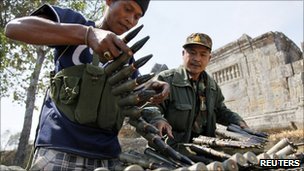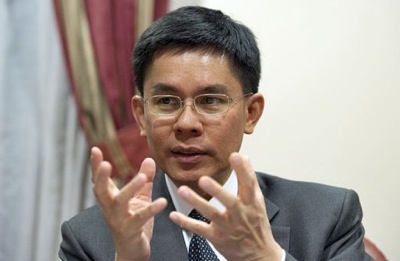Note: This post contains a story I wrote for the fall, 2010 issue of Dateline, the magazine of the Foreign Correspondents’ Club of Thailand. I am reproducing the article here with the club’s permission. I have added images and links to various Web sites, but the text remains the same.
Social media and Thailand’s red shirt protests
By Newley Purnell
While covering Bangkok’s anti-government red shirt protests during April and May, Associated Press journalist Thanyarat Doksone read a report on Twitter from a Thai radio station saying that the demonstrations had spread to the Asoke area of the Thai capital.

She was in a different part of town, so the Lampang native typed a message to her own “followers” on the microblogging service to see if any of them could confirm the development. But it turned out not to be true. One of her followers was in the area, noted that all was quiet — and even posted an image to prove that there was no unrest of note.
The episode underlines a changing communications ecosystem: As in other countries where news is breaking, tech-savvy residents in Thailand used a variety of outlets to stay abreast of the rapidly developing events during the red shirt demonstrations.
As in years past, people who wanted to follow the unrest could read newspaper reports, watch the events on TV, listen to the radio, and speak with friends and family. But this spring, unlike during previous bouts of political instability, Thailand residents increasingly took advantage of social media outlets like Twitter and Facebook to share and collect information about what was happening around them.
Twitter’s world-wide rise has been rapid. When ousted Prime Minister Thaksin Shinawatra was overthrown in a military coup in 2006, Twitter’s three founders in the U.S. had just launched the service. Now, four years later, the company says the site receives 190 million visitors per month, and an astounding 65 million Twitter messages, or tweets, are sent out every day.

Prominent figures in Thailand who have Twitter accounts include Prime Minister Abhisit Vejjajiva (112,000 followers), Finance Minister Korn Chatikavanij (41,000 followers), and Nation editor Sutichai Yoon (83,000 followers). And of course, much to the government’s chagrin, former Prime Minister Thaksin (114,000 followers) — or one of his aides — posts frequent snippets during his many travels.
Around the world, critics dismiss the service’s 140-character-or-less bursts as shallow and irrelevant. After all, goes the saying, do we really care what you had for breakfast? But Twitter, increasingly, has political implications.
In June 2009, the service was used inside and outside Iran to share information about events on the ground following President Mahmoud Ahmadinejad’s controversial election. Amid media censorship inside Iran, the U.S. State Department even asked Twitter to continue operating rather than shut down briefly for scheduled maintenance.
Here in Thailand, Mark MacKinnon, East Asia correspondent for Canada’s The Globe and Mail newspaper, says that Twitter helped him in reporting the red shirt protests by allowing him to gather information from a wide variety of outlets. He used the service to take the temperature in various parts of town, and found that his postings allowed him to preserve — and publish — bits of local color throughout the day that might otherwise have been confined to his notebook. His newspaper even ran collections of his running tweets, providing a compelling narrative for global readers as events developed here.
Twitter would also play a more serious role during MacKinnon’s time in Bangkok. He was caught in the city’s Wat Pathum temple while reporting the military crackdown on May 19. MacKinnon was with Andrew Buncombe, a journalist for London’s Independent newspaper, when Buncombe was shot and injured after the temple came under fire. Neither Buncombe nor the other wounded civilians trapped inside were able to exit.
After calling embassies and hospitals, MacKinnon used Twitter to ask for help in urging authorities to stop the gunfire so that the injured could be evacuated. “People around me are dying because they can’t get to hospital across the road because of fighting,” he tweeted, along with a photo of some of the injured.
The message was relayed, in turn, by his followers, and the dispatches were even posted on the Web site of London’s Guardian newspaper. Twitter “helped raise the volume,” he says, and “deserves some of the credit” in bringing about a resolution.
Jon Russell, a Saraburi-based freelance journalist who publishes a popular blog about social media in Asia, notes that people had used Twitter in Thailand in years past, but that the service grew in popularity during the red shirt protests. Journalists and news outlets began using Twitter, embracing the “real time potential of the service in a way that had never been done before in Thailand.”

Russell notes that Facebook, too, has grown rapidly in the Kingdom, and that Thailand is among the top five fastest-growing Facebook markets globally. He says that while Twitter users tend to be open to debate, due to its closed nature, Facebook interactions can be more one-sided.
Eric Seldin, a veteran cameraman who runs Bangkok’s Thaicam Production Services, posted his observations and images to Twitter throughout the red shirt protests. His followers grew from approximately 400 to 800 within just a week, he says, as people increasingly craved information about the events unfolding in Bangkok. Seldin even used the service to guide a German camera crew with whom he was working. He could monitor events throughout the city, using Twitter as “original raw sourcing, and then double and triple confirming,” he says. “I could use Twitter as a clearinghouse.”
He adds that the transparent nature of the service allowed users to quickly verify who was trustworthy and who wasn’t. Media might report one version of events, but individuals could quickly post images, videos, or text accounts — in real time — that refuted or supported these descriptions. “When there was misinformation” from the media or individuals, “people called them on it,” he says.
Richard Barrow, a prolific blogger who lives in Samut Prakarn and runs a network of Thailand-related Web sites, shared numerous images and accounts during the protests with his more than 5,000 followers. During the unrest, “Twitter provided us with a much faster and efficient source of breaking news,” he said in an email. “Literally. What is better than a someone on the scene taking pictures and uploading them onto Twitter and Facebook?” He adds that Thailand’s newspapers may have political biases, whereas so-called “citizen journalists” often do not.
After noticing that local papers weren’t keeping up with the rapidly developing events in Bangkok, Barrow even created a Google Map he labeled “Bangkok Dangerous.” He plotted on it, in English, locations where protests and clashes were taking place. He updated it frequently, and the guide ultimately filled a void: It has been viewed some 2.7 million times to date, he says.

To be sure, Twitter and Facebook have their drawbacks. Reliability is one issue. Few people would use such services for their sole sources of information, and most regard them as a supplement to products of traditional journalism. Still, it’s clear to those who use Twitter, especially, that — just as in every other facet of life — some people inspire trust, while others do not. Readers — and those doing the tweeting — must proceed with caution.
Another risk is political polarization and the temptation to be more rude online than one would be in public. MacKinnon notes that social media tends to allow people to act differently toward others than the might otherwise. During the protests, he noticed exchanges on Twitter that included “things people wouldn’t say if they saw each other in the street.” he says. “People were being hateful.”
In addition, in a world of shorter attention spans and ever-proliferating media, there is another challenge to journalists: Twitter is yet another information stream to be monitored. And this leads, quite simply, to more work.
Thanyarat says that Twitter can be quite helpful, “but it also adds the burden of fact checking.” she says. “You have to get through the noise to get at what’s really useful. And in a way it adds to your tasks.”






